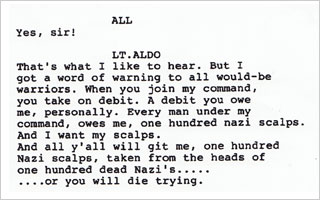
Photo: Getty Images
…and it is exactly as batshit over-the-top insane as we hoped.
The copy we acquired includes a handwritten cover page which we think might actually be in Tarantino's handwriting, reading, "INGLOURIOUS BASTERDS." This misspelling of "bastards" continues through the screenplay, suggesting we were right when we guessed Tarantino was writing really, really fast. He doesn't even have time to spell-check if he's gonna get this movie turned around by Cannes!

The Bastards' and Shosanna's stories intersect when a gala premiere of a Goebbels-produced propaganda film is put on in Shosanna's theater, with Hitler and most of the German High Command scheduled to attend. Both the Bastards and Shosanna launch plots intending to end the war a little earlier than anyone expected.
The script's divided into five chapters:
Chapter One: Once Upon a Time … Nazi Occupied FranceChapter Two: Inglorious Basterds
Chapter Three: German Night in Paris
Chapter Four: Operation Kino
Chapter Five: Revenge of the Giant Face
The first chapter, set in 1941, introduces Shosanna and the film's antagonist, a Nazi officer named Landa who's known as the "Jew Hunter." The second chapter introduces the Bastards and their tactics: They kill Nazis on sight, take their scalps, and — when they let one go — carve a swastika into his forehead. The third chapter, set in 1944, reintroduces Shosanna in Paris ("This whole Chapter will be filmed in French New Wave Black and White"). The fourth sets up the Bastards' attack on the theater. And it all comes together in Chapter Five, which plays fast and loose with history, to say the least.
The script is definitely the ur-text of Quentin Tarantino's career up to now; it combines his love of old movies (war movies, Westerns, and even prewar German cinema), his attraction to powerful female protagonists, his love of chatter, and his willingness to embrace the extreme — visually and in his storytelling. (The flashbacks have particularly Tarantinoian flourishes: a thought bubble pops out of a character's head to introduce one, while another is shot spaghetti Western style.) All in all, it reads like Kill Bill meets The Dirty Dozen meets Cinema Paradiso.
We wondered at times if this script was a fake, and it's still possible that it is — but if so, it's such a skillful fake that the author has even mastered Tarantino's ability to write moments that seem almost like parodies of his own tastes. Such as, for example, our favorite moment in the screenplay, with a mix of fetishism and inspired comedy that feels authentically alive. Late in chapter four, the Nazis are preparing Shosanna's movie theater for its big premiere, and Goebbels tells her that he appreciates "the modesty of this auditorium." Then he suggests sprucing the place up a bit, with a chandelier from Versailles and a couple of Greek nudes from the Louvre scattered around the lobby. A quick montage shows this happening, and then Tarantino describes the result:
We see Workers trying with incredible difficulty, to hoist the huge, heavy, and twinkingly fragile chandelier, in Shosannas auditorium, which now resembles something out of one of Tinto Brass's Italian B-movie rip-off's of Visconti's "The Damned".
If anyone is crazy enough to fund it, this movie is gonna be awesome.

Bęta viš athugasemd [Innskrįning]
Ekki er lengur hęgt aš skrifa athugasemdir viš fęrsluna, žar sem tķmamörk į athugasemdir eru lišin.